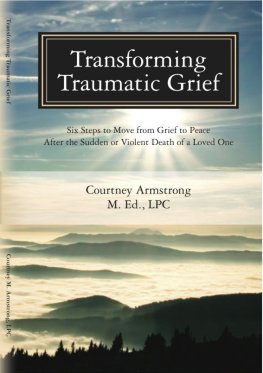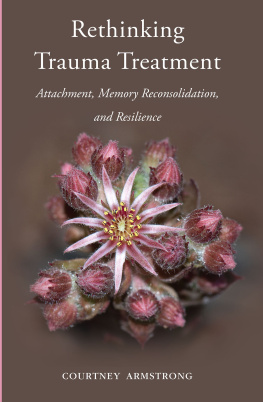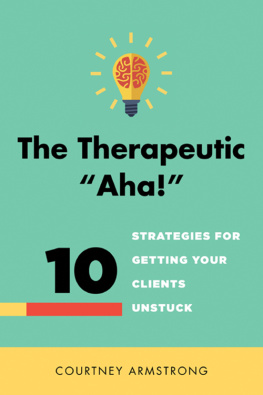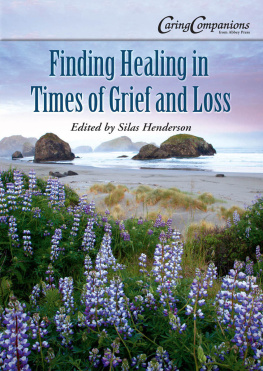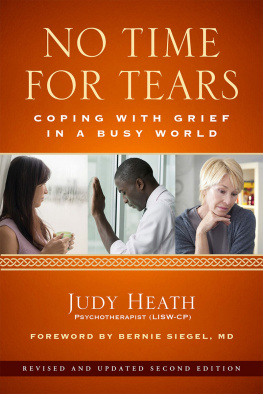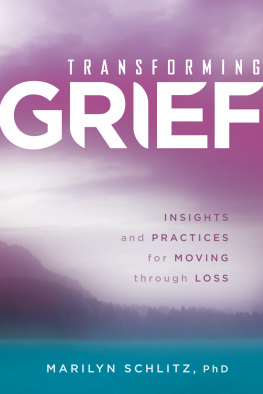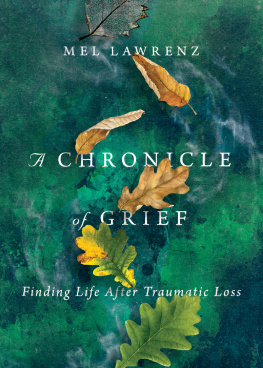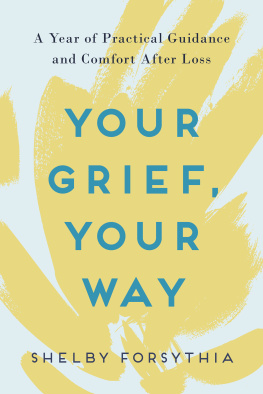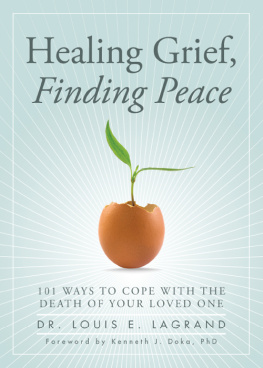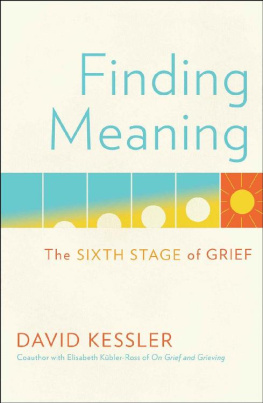Transforming TraumaticGrief
Courtney Armstrong, M. Ed., LPC/MHSP
Published by Artemecia Press
Smashwords Edition
Copyright 2011 Courtney Armstrong
ISBN: 978-0-9834999-0-9
For more tools and updates, visit theauthors websites:
http://www.courtneyarmstronglpc.com
http://traumatherapyalternatives.com
http://www.transformingtraumaticgrief.com
*****
Authors Note
Cases described in this bookare composites of typical client stories. Some stories have beencombined and names or other identifying details have been changedto protect privacy .
Although this book offers tools to help you through the grief process,it is not a substitute for professional help. Please contact amental health professional if you need additionalsupport.
*****
Table ofContents
About theAuthor
Acknowledgements
*****
Introduction
L osing someone you love to a suddenor violent death is a shocking and life changing experience. Yourworld can feel turned upside down as you attempt to make sense ofwhat happened. Some days may seem completely normal or unreal, asif nothing has happened. Other days you might struggle with intensefeelings of anxiety, anger, guilt, or despair. Disturbing thoughtsand images can haunt you as you attempt to understand thecircumstances leading to the death and wonder how the death couldhave been prevented. After my aunt died from a terrible accident,my uncle commented, I can relate to the Greek tragedies where menare in such gut-wrenching pain that they rip off their clothes.Wrenching really is the right word for it.
You may feel isolated whenfriends do not know how to respond, or family members distance orbring up old conflicts. There is a strong yearning to connect withyour deceased loved one and know that he or she is okay, especiallyif there were unresolved issues before the death. You could also bedealing with legal investigations, insurance challenges, and mediaattention that further complicate things.
Traumatic grief can alsooccur after a series of sudden losses. This happened to me, whichprompted me to write this book. In 2005,following a year of agonizing infertility treatments, I lostmultiple pregnancies and was told I would never be able to havechildren. I tried to reason my way through the grief and hide mypain from friends, but deep down I ached with sorrow, anger, andconfusion. My husband patiently supported me as best he could, buta few months later, his mother died, leaving him griefstricken.
Right after my mother-in-laws death, myaunt was run over and killed by a large truck while crossing astreet in downtown Seattle. My family was already preparingthemselves for the passing of another aunt who had terminal cancer.So the shock of Aunt Bevs death was doubly difficult. Nonetheless,I soldiered on until August, when Hurricane Katrina hit NewOrleans. As the levies broke down, my emotional levies broke downtoo. I was flooded with pain, tears, and nightmares for weeks. NewOrleans had been my home for several years while I was pursuing mygraduate degree in counseling, and I deeply loved her. I workedwith inner-city families caught up in gang violence and poverty inNew Orleans, and I deeply loved them too. These were the samefamilies being interviewed at the Superdome on the nightly news. Iwatched in horror as reporters showed people lying dead in thestreet, violent assaults, and unanswered pleas for help.
Traumatic grief was also showing up morefrequently in my therapy practice. More and more I began to seeclients overcome with anxiety and depression after losing lovedones to suicide, accidents, violence, or war. Even if the deathhappened years ago, griefs shadow was still looming over theirlives and they desperately wanted peace.
Tragic losses then began to strike myfriends. A close friends father fatally shot her brother and thenkilled himself. Next, a friend of my husbands was killed when hestopped to help somebody on the side of the road. Another friendsfather died suddenly from anaphylactic shock after taking anover-the-counter medicine. I wanted to help these friends, butoften felt as helpless as they did.
Determined to find a way to help people copewith sudden, traumatic losses, I scoured books and researchregarding effective ways to heal from these tragedies and pursuedadvanced training in the treatment of grief and trauma. I learnedthat you do not have to sit passively and let time pass in order toheal. There are tools you can use and steps you can take to relievethe pain and create new meaning in your life. I have written thisbook to share an approach to healing based on what I have learnedfrom recent advances in trauma and grief treatment, and mostimportant, what I have learned from my clients as weve used andrefined this approach over the last several years.
In Chapter 1, Idescribe The Experience of TraumaticGrief , because many people who are goingthrough this type of bereavement wonder if what they areexperiencing is normal. While everyones grief process is unique,this chapter will give you a sense of what is typical and reassureyou that you are not alone in your experience.
In Chapter 2, Overview of EMERGE and the Science BehindIt , I present an overview of an approachfor transforming traumatic grief that I call EMERGE. I use theacronym, EMERGE, for six steps you can use to move from grief topeace. These steps are: 1) Engaging mindfulness, 2) Making livingstories, 3) Envisioning connection, 4) Reprocessing traumaticmemories, 5) Generating new meanings, and 6) Establishingcommunity. You will also learn about research that supports theeffectiveness of each of these steps.
In Chapter 3, Engaging Mindfulness ,you will learn mindfulness, breathing, and meditation tools thatwill help you manage intense waves of emotion and ground you whenyou are feeling numb or detached. You will also learn the value ofgiving yourself permission to slow down and focus on only one thingat a time.
Chapter 4, Making Living Stories ,gives you several ways to positively reminisce and createmeaningful stories that highlight your loved ones specialqualities and gifts. This is a beneficial process because whensomeone dies traumatically, their dying story tends to becomelarger than their living story. Doing the activities in thischapter will bring your loved ones living story back to theforefront.
Chapter 5, Envisioning Connection ,you will learn several ways to envision ongoing connection to yourloved one, redefine your relationship with them, and feel comfortedwhen you think of them.
In Chapter 6, Reprocessing TraumaticMemories , you will learn how to stopdisturbing images, painful memories, and nightmares from hauntingyou.
In Chapter 7, Generating New Meanings ,you will learn that the way we make meaning of our lives after aloss is strongly correlated with how well we adjust. This chapterhelps you expose and revise unhelpful meanings that you may haveassociated with the loss and consider ways to create new meaning inyour life.
Chapter 8, Establishing Community ,addresses the value of having social support and connecting tosomething larger than yourself. Although social support isfrequently touted as an antidote to depression and prolonged grief,reaching out for social support when you are grieving is hard. Thischapter discusses ways to get the support you want and provides alist of helpful resources.
Chapter 9, EMERGE: A Light for theDarkness , summarizes the steps of EMERGE,comparing the process of emerging from the heavy cocoon of grief tothe process of the butterfly emerging from a chrysalis. You toowill emerge like the butterfly, transformed into somethingdifferent but beautiful. The steps of EMERGE will help you throughthis process.
*****
Chapter 1: The Experienceof Traumatic Grief
A lthough traumatic griefhas some similarities to the grief one feels after an expecteddeath, the sudden or violent death of a loved one challenges andchanges every aspect of a persons life. Priorities change, beliefschange, relationships change, and as one griever noted, Your wholeidentity changes.
Next page
